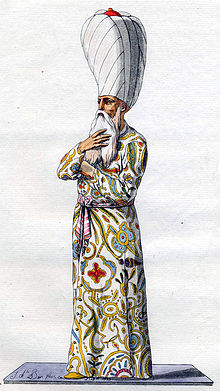| Izzet MehmedPasha | |
|---|---|
| Grand Vizier of the Ottoman Empire | |
| In office 10 August 1774 – 7 July 1775 | |
| Monarch | Abdülhamit I |
| Preceded by | Muhsinzade Mehmed Pasha |
| Succeeded by | Moralı Dervish Mehmed Pasha |
| In office 20 February 1781 – 25 August 1782 | |
| Monarch | Abdülhamit I |
| Preceded by | Silahdar Seyyid Mehmed Pasha [tr] |
| Succeeded by | Yeğen Hacı Mehmed Pasha [tr] |
| Ottoman Governor of Egypt | |
| In office 1775 – 15 July 1778 | |
| Preceded by | Hacı Ibrahim Pasha |
| Succeeded by | Raif Ismail Pasha |
| Personal details | |
| Born | 1723 |
| Died | February 1784 Belgrade, Ottoman Serbia |
| Nationality | Ottoman |
Izzet Mehmed Pasha (1723 – February 1784, Belgrade) was an Ottoman statesman who served as the Grand Vizier of the Ottoman Empire twice, first from 1774 to 1775, and second from 1781 to 1782.

Towards the end of Russo-Turkish War (1768-1774), he was the sadaret kaymakamı, deputy to the grand vizier who served in the absence of the grand vizier. Sultan Abdülhamit I appointed him as grand vizier on 10 August 1774. His first term ended on 7 July 1775. Six years later, while he was serving as the governor of Erzurum Eyalet, he was reappointed as the grand vizier on 20 February 1781. His main task was reforming the army which was unsuccessful in the war. But in this task he failed to satisfy the sultan, and furthermore, a fire in Istanbul caused great damage and riots, leading to his dismissal by the sultan on 25 August 1782 and exile to Plovdiv.
Apart from the grand viziership, Izzet Mehmed Pasha also held other high-level posts. He became a vizier on 6 July 1774, and he served as the Ottoman governor of Aidin (1775), Egypt (1775–78), Sivas (1778–79), Erzurum (1779, 1780–81), Rakka (1779–80), and Belgrade (1783–84).
He died in February 1784 in Belgrade while in office as its governor.
See also
References
- ^ Mehmet Süreyya (1996) , Nuri Akbayar; Seyit A. Kahraman (eds.), Sicill-i Osmanî (in Turkish), Beşiktaş, Istanbul: Türkiye Kültür Bakanlığı and Türkiye Ekonomik ve Toplumsal Tarih Vakfı, pp. 848–849, ISBN 9789753330411
- ^ Prof. Yaşar Yüce-Prof. Ali Sevim: Türkiye tarihi Cilt IV, AKDTYKTTK Yayınları, İstanbul, 1991 p 75
- Tualimforum page (in Turkish)
- 'Abd al-Rahman Jabarti; Thomas Philipp; Moshe Perlmann (1994). Abd Al-Rahmann Al-Jabarti's History of Egypt. Vol. 2. Franz Steiner Verlag Stuttgart. p. 119.
- 'Abd al-Rahman Jabarti; Thomas Philipp; Moshe Perlmann (1994). Abd Al-Rahmann Al-Jabarti's History of Egypt. Vol. 2. Franz Steiner Verlag Stuttgart. p. 36.
- 'Abd al-Rahman Jabarti; Thomas Philipp; Moshe Perlmann (1994). Abd Al-Rahmann Al-Jabarti's History of Egypt. Vol. 2. Franz Steiner Verlag Stuttgart. p. 1.
| Political offices | ||
|---|---|---|
| Preceded byMuhsinzade Mehmet Pasha | Grand Vizier of the Ottoman Empire 10 August 1774 – 7 July 1775 |
Succeeded byMoralı Derviş Mehmet Pasha |
| Preceded byHacı Ibrahim Pasha | Ottoman Governor of Egypt 1775 – 15 July 1778 |
Succeeded byRaif Ismail Pasha |
| Preceded bySilahdar Seyyid Mehmed Pasha [tr] | Grand Vizier of the Ottoman Empire 20 February 1781 – 25 August 1782 |
Succeeded byYeğen Hacı Mehmet Pasha |
This Ottoman biographical article is a stub. You can help Misplaced Pages by expanding it. |